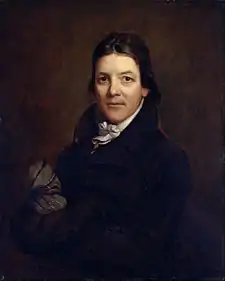Tertium quids
The tertium quids (sometimes shortened to quids) refers to various factions of the Democratic-Republican Party in the United States from 1804 to 1812.
Old Republicans | |
|---|---|
| Leaders | Morgan Lewis John Randolph John Taylor Nathaniel Macon |
| Founded | 1806 |
| Dissolved | 1828 |
| Merged into | Jacksonian Democrats |
| Ideology | Anti-expansionism Conservatism Jeffersonianism Liberalism Classical liberalism Republicanism |
| Political position | Center |
| National affiliation | Democratic-Republican Party |
| Colors | Orange |
In Latin, tertium quid means "a third something". Initially, quid was a disparaging term that referred to cross-party coalitions of Federalists and moderate Democratic-Republicans, such as those who supported the election of Thomas McKean to Governor of Pennsylvania in 1805. However, by the 1810s, the term would later and more famously be used to refer to the hardline faction of the Democratic-Republican Party. This group, also called the Old Republicans, strongly opposed the Federalist Party's policies to a greater degree than the emerging moderate Democratic-Republican leadership.
Pennsylvania
Between 1801 and 1806, rival factions of Jeffersonian Republicans in Philadelphia engaged in intense public debate and vigorous political competition that pitted radical Democrats against moderates, who defended the traditional rights of the propertied classes. The radicals, led by William Duane, the publisher of the Jeffersonian Aurora, agitated for legislative reforms that would increase popular representation and the power of the poor and the laboring classes. Moderates successfully outmaneuvered their radical opponents and kept the Pennsylvania legislature friendly to the emergent liberal capitalism. The term was first used in 1804 to refer to the moderates, especially a faction of the Republican Party that called itself the Society of Constitutional Republicans. They gathered Federalist support and in 1805 re-elected Governor Thomas McKean, who had been elected by a united Republican Party in 1802 but had broken with the party's majority wing.[1][2]
New York State
In New York State, the term was applied to the Republican Party faction that remained loyal to Governor Morgan Lewis after he had been repudiated by the party's majority, led by DeWitt Clinton.
The New York State and Pennsylvania Quid factions had no connection with each other at the federal level, and both supported US President Thomas Jefferson.[3]
Virginia

When Virginia Representative John Randolph of Roanoke broke with Jefferson and James Madison in 1806, his faction was called the "Quids." Randolph was the leader of the Old Republican faction, which insisted on strict adherence to the US Constitution. He summarized Old Republican principles as "love of peace, hatred of offensive war, jealousy of the state governments toward the general government; a dread of standing armies; a loathing of public debts, taxes, and excises; tenderness for the liberty of the citizen; jealousy, Argus-eyed jealousy of the patronage of the President""[4]
Randolph made no effort to align with either Quid faction in the states and made no effort to build a third party at the federal level. He supported James Monroe against Madison during the runup to the presidential election of 1808. However, the state Quids supported Madison and were led by Randolph, who had started as Jefferson's leader in the House but became his most bitter enemy. Randolph denounced the compromise on the Yazoo Purchase in 1804 as totally corrupt. After Randolph failed to impeach a Supreme Court justice in 1805, he became embittered with Jefferson and Madison and complained: "Everything and everybody seem to be jumbled out of place, except a few men who are steeped in supine indifference, whilst meddling fools and designing knaves are governing the country""[5] He refused to help fund Jefferson's secret purchase of Florida from Spain. Increasingly, Randolph felt that Jefferson was adopting Federalist policies and betraying the true party spirit. In 1806, he wrote to an ally that "the Administration... favors federal principles, and, with the exception of a few great rival characters, federal men.... The old Republican party is already ruined, past redemption. New men and new maxims are the order of the day."[5]
Randolph's increasingly strident rhetoric limited his influence, and he was never able to build a coalition to stop Jefferson. However, many of his supporters lived on and, by 1824, had looked to Andrew Jackson to resurrect what they called "Old Republicanism."
See also
Notes
- Shankman, Andrew (Spring 1999). "Malcontents and Tertium Quids: The Battle to Define Democracy in Jeffersonian Philadelphia". Journal of the Early Republic. 19 (1): 43–72. doi:10.2307/3124922. JSTOR 3124922.
- Phillips, Kim T. (1977). "William Duane, Philadelphia's Democratic Republicans, and the Origins of Modern Politics". Pennsylvania Magazine of History and Biography: 365–387.
- Junius P. Rodriguez, ed. (2002). The Louisiana Purchase: A Historical and Geographical Encyclopedia.
- McCarthy, Daniel (August 1, 2005). "Liberty and Order in the Slave Society". The American Conservative
- Risjord (1965), p. 42.
References
- Cunningham Jr., Noble E. (September 1963). "Who Were the Quids?". The Mississippi Valley Historical Review. 50 (2): 252–263. doi:10.2307/1902756. JSTOR 1902756.
- Risjord, Norman K. (1965). The Old Republicans: Southern Conservatism in the Age of Jefferson.CS1 maint: ref=harv (link) The standard history of the Randolph faction.
- Sheldon, Garrett Ward; Hill Jr., C. William (2008). The Liberal Republicanism of John Taylor of Caroline.